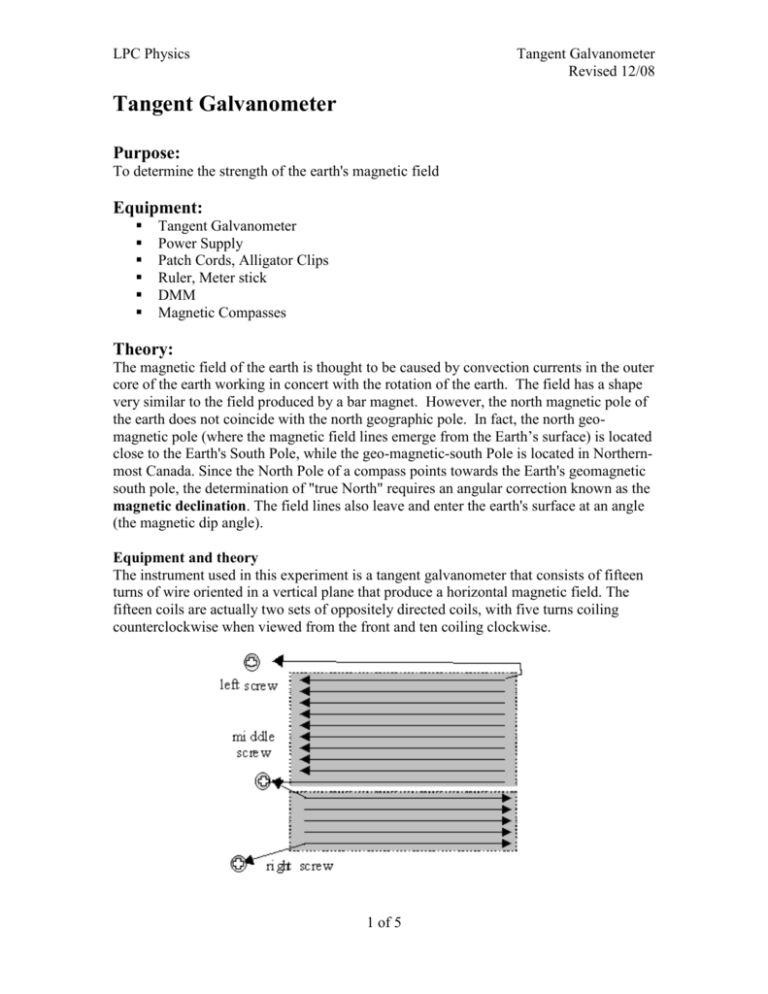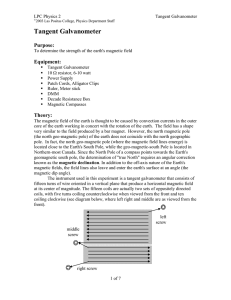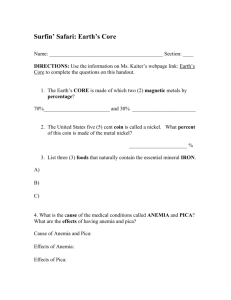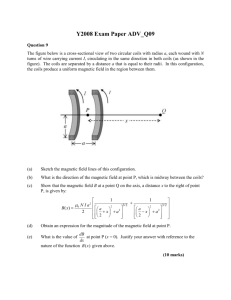LAB X: Title - Las Positas College
advertisement

LPC Physics Tangent Galvanometer Revised 12/08 Tangent Galvanometer Purpose: To determine the strength of the earth's magnetic field Equipment: Tangent Galvanometer Power Supply Patch Cords, Alligator Clips Ruler, Meter stick DMM Magnetic Compasses Theory: The magnetic field of the earth is thought to be caused by convection currents in the outer core of the earth working in concert with the rotation of the earth. The field has a shape very similar to the field produced by a bar magnet. However, the north magnetic pole of the earth does not coincide with the north geographic pole. In fact, the north geomagnetic pole (where the magnetic field lines emerge from the Earth’s surface) is located close to the Earth's South Pole, while the geo-magnetic-south Pole is located in Northernmost Canada. Since the North Pole of a compass points towards the Earth's geomagnetic south pole, the determination of "true North" requires an angular correction known as the magnetic declination. The field lines also leave and enter the earth's surface at an angle (the magnetic dip angle). Equipment and theory The instrument used in this experiment is a tangent galvanometer that consists of fifteen turns of wire oriented in a vertical plane that produce a horizontal magnetic field. The fifteen coils are actually two sets of oppositely directed coils, with five turns coiling counterclockwise when viewed from the front and ten coiling clockwise. 1 of 5 LPC Physics Tangent Galvanometer Revised 12/08 From the Biot-Savart law, the magnetic field at the center of the coil due only to the current I is given by: Bc o NI Eq. 1 2R is the permeability of free space where: N is the number of turns of wire I is the current in the wires R is the mean radius of the coils. Note that this field vector is perpendicular to the plane of the coil. If the coils of the galvanometer are oriented so that the Earth's magnetic field (Be) is parallel to the plane of the coils, and the magnetic field due to the current (Be) is perpendicular to the coils (as shown below) the net field B is the vector sum of the two. B B e Bc Figure l. The net magnetic field, B From Figure 1, it can be seen that the horizontal component of the earth's magnetic field Be can be expressed as tan Bc Be Eq. 2 where is the compass reading. Note that Eq. 2 can be rearranged to allow a linear relationship between Bc and tan o NI 2R Be tan Eq. 3 The horizontal component of the earth's field can now be found by measuring the field due to the coils and the direction of the net magnetic field relative to the direction of the earth's field. 2 of 5 LPC Physics Tangent Galvanometer Revised 12/08 Because a compass aligns itself with the lines of force of the magnetic field within which it is placed, a compass can be used to find the angle between Be and B. If the compass is first aligned with the magnetic field Be and current is then supplied to the coils, the compass needle will undergo an angular deflection. This angular deflection is . Experiment: 1. Connect the power supply to the tangent galvanometer. Use the left and middle screws so that the coil consists of ten turns. Power Supply A Tangent Galvanometer Figure 2. The net magnetic field B 2. Orient the tangent galvanometer so that the plane of the coils is parallel to the northsouth line as indicated by the compass without the applied field (see Figure 3.). The field produced by the coils will then be perpendicular to the earth's field. Figure 3. Positioning the Galvanometer 3 of 5 LPC Physics Tangent Galvanometer Revised 12/08 3. Use the power supply as a current source by turning the current knob counterclockwise as far as it will go and the voltage knob clockwise as far as it will go. 4. Have the professor or the lab tech check your circuit before turning on the power supply. Set the power supply to 0.2 amps. WARNING: The current used in this lab is very dangerous. Do not touch the equipment while the power supply is on. Turn off the power supply before making any changes to the equipment. 5. Record the angular deflection of the compass needle and it's uncertainty . 6. Record the current I and its uncertainty I. 7. Increase the current by about 0.2 amps and repeat steps 5 and 6. Continue to raise the current until you have a recorded at least 10 values. Do not go over 2 amps. 8. Measure the diameter of the coils on the tangent galvanometer. Analysis: 1. Use Eq. 3 to calculate the horizontal component of the earth's magnetic field for each angle. To do this you use Eq. 3 and plot Bc vs. tan or o NI vs. tan 2R so that Be will be the slope of your plot. Display your results graphically and determine Be from the your "best fit" straight line. 2. Unless you are extremely lucky, your results will not agree exactly with the accepted value (see below). As with most labs, however, your values need only agree within the experimental uncertainty. Using the techniques of error analysis, the uncertainty in Be using Eqs. 1 and 2 is given by: I R Be Be R sin cos I Eq. 4 where is in radians. 3. In this experiment, however, you are not calculating Be directly from a single equation, and one set of independent variables. Instead, you are performing a "best fit" from several data points. This implies that the best method for determining Be is to determine the maximum and minimum slopes that fit your data points. In doing so, be sure to include the uncertainties in the current and angle in creating your new ranges (i.e. graph Bc(I+I) vs. tan (Determine the values of Be max and Be min that are consistent with your data. Does the accepted value fall within this range? 4 of 5 LPC Physics Tangent Galvanometer Revised 12/08 4. Is there a particular angle at which you could suggest making measurements so as to minimize the angular uncertainty? Explain. Before you take the equipment apart, change the current until this angle is reached. Use Eq. 2 to determine the value of Be using this angle and current (if you don't already have this value in your data table). How does this value compare with the value you obtained in Step 2? 5. The Earth's magnetic field does not actually pass horizontally through the coils. Instead it comes in at an inclination angle, , so that Be = Bcos The local field strength, declination, and inclination can all be found at: http://www.ngdc.noaa.gov/seg/geomag/jsp/IGRFWMM.jsp Supplemental Questions (to be turned in with your lab report) 1. Where is the north magnetic pole of the earth located? 2. What is the magnetic declination? 3. What is the magnetic declination in the bay area? 4. Begin with the Biot-Savart Law and derive Eq. 1. 5. Derive Eq. 4 from Eq. 2 and 3. 5 of 5 Eq. 5









